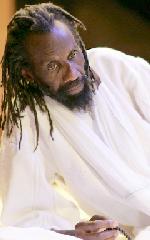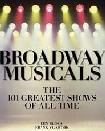SEARCH CurtainUp
REVIEWS
FEATURES
NEWS
Etcetera and
Short Term Listings
LISTINGS
Broadway
Off-Broadway
BOOKS and CDs
OTHER PLACES
Berkshires
London
LA/San Diego
DC
Philadelphia
Elsewhere
QUOTES
On TKTS
LETTERS TO EDITOR
FILM
LINKS
MISCELANEOUS
Free Updates
Masthead
Writing for CurtainUp NYC Weather
Tierno Bokar
By Brad Bradley

Sotigui Kouyaté
(Photo: Pascal Victor)
|
The title of this abstract play, one that often feels like a series of Socratic dialogues, refers to a Sufi mystic embroiled in a dispute between rival religious factions in 1930s French-ruled Africa. The play is the centerpiece of a month-long series of events at Columbia involving the residency of Brook’s International Center of Theatre Creation (CICT) and Theatre des Bouffes du Nord. The current production is the American premiere of the work following engagements in Paris and elsewhere in Europe. In an unusual statement, Columbia’s President Lee C. Bollinger described Brook’s residency as “"an important point of intersection between the arts and scholarship, " and [that]. . .Tierno Bokar "exemplifies the unique power of artistic expression to illuminate he most enduring social questions of our times."
Of course, this play is considerably closer to say, Samuel Beckett’s Waiting for Godot, with a series of existential and perhaps unanswerable questions at its core than say, the current batch of new musicals on Broadway, which mostly discourage thinking in deference to cozy and hopefully popular nostalgia. Tierno Bokar does, however, include a notable musical element, and the haunting and exotic background music composed for the play by Toshi Tsuchitori and Antonin Stahly is in some respects as powerful as the play itself. I would like to credit both some individual actors as well as the onstage musicians (who also sometimes double as actors), but the program information provides no details as to the performing artists’ assignments. The richly developed performances are spirited, often engaging, and occasionally even humorous.
Born in 1925, Peter Brook began his theatrical career as a wunderkind director barelyout of his teens with an innovative 1946 production of Shakespeare’s early comedy Love’s Labour’s Lost. He has remained iconoclastic for the nearly 60 years of his theater and film career thus far. In his 1968 book, The Open Space, Brook described four types of theater: deadly (i.e., boring), holy (perhaps inspiring the spirit), rough (i.e., as life is), and immediate (i.e., vital and engaging). While he predictably sees the immediate as the polar opposite of the deadly, he considers the best theater to be a combination of the rough with the holy. He aspires to touch the audience "beyond the surface of everyday life." His published philosophical statements were followed quickly by his groundbreaking memorable production of A Midsummer Night’s Dream which he considered as folk theater and in fact placed in an empty space, essentially white, while using trapezes and stilts for varying spacial effects.
For most of the succeeding thirty-five years, Brook has worked out of a base in Paris, often developing projects elsewhere such as Iran and in the present case, Africa. Tierno Bokar itself employs a not quite empty space, one punctuated by various bright floor mats and anchored by a naked tree trunk at its center even as the action moves to various geographic locales; throughout the performance, that sole tree trunk silently invokes the aforementioned central Beckett play which first saw stages in Brook’s youth half a century ago.
Brook’s concern for elevating pure sound above the importance of text is undercut somewhat here. There is so much text,and because most of the audience members, lacking fluent French, are impelled to read the (very readable) supertitles, unfortunately losing some degree of the impact of the sound and ritual coming from the stage. As a result, Brook’s desire to make theater more s"imple … and direct … and transparent" is undercut at times by the sheer density of the text employed, not unlike an experience of attending a very talky film in which all the dialogue is received by subtitles.
Some years ago, when he was working on his nearly ten-year epic project, The Mahabharata, Brook acknowledged that in attempting to convey the whole of human experience, he had created some abstraction of images. In the current project, placed nearly 75 years ago, he continues to use non-western settings and images to speak to an international audience. His contributions to a world theater are unmatched. Although Tierno Bokar offers relevant resonances to contemporary social and political conflict and injustice, the abstractions onstage sometimes stand in the way of clarity.
The character of Bokar is left to the background for much of the performance’s first half, and his programmatic and ritualistic prayers to God and his sage advice to a student are both predictable ("accept your lot without complaint,""treat the elderly with respect") and deliberately enigmatic ("there are three truths: my truth, your truth, and the truth.") Bokar’s behavior conveys an image of peace and purity, invoking images of his better known contemporary Gandhi, or currently, the barely deceased Pope John Paul II for his power to rally productive support in the face of crisis. All three leaders faced considerable spiritual journeys that led to further empowerment in death. For patient audiences who themselves can transcend conventional and/or linear theatrical expectations, Tierno Bokar may be a richly provocative and rewarding experience.
| Tierno Bokar
–
Text by Marie-Helene Estienne as adapted from Amadou Hampate Ba’s The Life and Teaching of Tierno Bokar, The Sage of Bandiagara A theatrical research by Peter Brook Music by Toshi Tsuchitori and Antonin Stahly Lighting Design: Philippe Vialatte Scenic elements: Abdou Ouologuem Produced by The Theatre des Bouffes du Nord at Columbia’s Miller Theatre,3009 Broadway at 117th Street, 212-239-6200 From 3/30/05 to 4/26/05; opened 4/06/05 Tuesdays through Saturdays at 8. Sundays at 3. Running time: 100 minutes (no intermission). Viewed by Brad Bradley at the Saturday, April 2, 2005 press preview. |

Easy-on-the budget super gift for yourself and your musical loving friends. Tons of gorgeous pictures.

Retold by Tina Packer of Shakespeare & Co.
Click image to buy.
Our Review

At This Theater

Leonard Maltin's 2005 Movie Guide

Ridiculous!The Theatrical Life & Times of Charles Ludlam

6, 500 Comparative Phrases including 800 Shakespearean Metaphors by CurtainUp's editor.
Click image to buy.
Go here for details and larger image.



